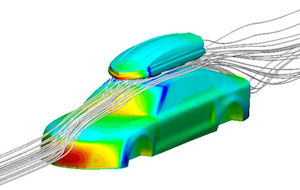Fast App: Precious Cargo
Thule leverages IMAGINiT's CFD analysis services to design a new cargo box line.

Latest News
July 11, 2013
Established in Sweden in 1942, Thule is a global company that designs and manufactures premium products that allow people to easily bring sports and other gear with them. Their product lines include roof racks, bike and water sport carriers, as well as rooftop cargo boxes. Thule’s design leadership and technology innovation defined the rooftop cargo box market. From making a product easier to use, to taking the hassle out of gear transportation, Thule’s goal is to continuously create superior products and better product experiences for customers.
The Challenge
“Concerns in our marketplace over fuel economy, sleek design, and a quiet ride have made aerodynamics increasingly more important to our cargo box designs. Partnering with IMAGINiT helped us to define how air flows around different box shapes. Their engineers were then able to recommend changes in geometry that balanced between reduced wind drag and the premium aesthetics that our customers expect. The IMAGINiT team brought top-notch expertise in analysis, simulation and aerodynamics, as well as a professional and transparent communication style that forged a great relationship and culminated in a very successful project.”
— Joe Flaherty, Chief Engineer for Thule |
Thule’s design team was tasked with the tall order of producing a new design that would push the top end of the cargo box market. The outdoor industry trade show season required the new “Sonic” line to launch well before the spring cargo box purchasing surge. The combination of aesthetics and performance that Thule brings to cargo box design commands premium prices, so the designers wanted tangible performance improvements that would permanently raise the bar across the premium cargo box industry.
“People respond positively to our designs because they are both highly functional and visually beautiful,” says Thule Product Manager Ian McLeran. “We knew that by leading in aerodynamics, we could benefit the cargo box consumer more than ever before, but we needed help to define the shape that would take us there.”
Thule’s US team sought out IMAGINiT’s Computational Fluid Dynamics (CFD) Analysis Consulting team because they wanted a local service provider that had extensive CFD expertise with aerodynamic applications.
“We wanted to get almost instant feedback and make immediate progress,” McLeran explains. “Our timeline was tight and the work performed would have an impact on everything downstream regarding this product line, so we needed to get answers fast. Tooling on thermoplastics is complex, and just a couple of extra days in turnaround would affect the whole project timeline. After speaking to the IMAGINiT team a couple of times, I could tell they understood our business and the specific goals of this project. There was frequent communication and discussion between our teams, and in the end it didn’t feel like we were working with an outside company at all.”
The Solution
Because both IMAGINiT and Thule share a similar vision of business success, value a customer-centric focus, and prefer a collaborative approach, Thule hired the IMAGINiT CFD team to work alongside its engineering and design staff to produce a comprehensive CFD analysis of its existing designs for the new Sonic cargo carriers.
“We analyzed the proposed designs that Thule gave us to identify areas of high drag, and the root cause of that drag,” explains Jason Pfeiffer, director of CFD Consulting with IMAGINiT. “Then we simulated suggested design changes based on insight uncovered to visually demonstrate to Thule engineers how they could alter their design to reduce drag and improve fuel efficiency for their customers.”
The insights that IMAGINiT CFD analyses provided resulted in a 35% reduction in drag coefficient over the initial design, leading to the development of the trademark Thule AeroNose.
“The improved aerodynamic profile that IMAGINiT provided results in much greater fuel efficiency for owners,” says McLeran. “Because this is a premium cargo box series, it is important to show the consumer a long-term return on their investment — and in this case, fuel savings make the Sonic cargo boxes attractive.”
Benefits and Results
Meeting go-to-market deadlines: Time-to-market is everything in the manufacturing business. Introducing new products with key performance advantages brings new revenues, and Thule’s engineering team made its deadline.
“Working with IMAGINiT was awesome,” McLeran enthuses. “There was never a reason to go back to them and say ‘Hey guys, this isn’t what we were asking for.’ The work was dead-on every time, and they were really giving us what we wanted. When there was a deliverable, these guys hit it and we were able to proceed to the next phase with confidence, allowing us to get the product to market before our deadline.”
Competitive advantage: The new AeroNose, along with a streamlined box design, reduced drag by 35% — allowing Thule to market its sustainable design and improved fuel efficiency characteristics.
“We are a premium brand, and IMAGINiT provided us with a proven, compelling competitive advantage,” says McLeran. “We are also using the empirical evidence regarding aerodynamic efficiencies directly in our advertising campaigns, including the actual images from their CFD analyses.”
Setting the pace of innovation: The new design for the Sonic line pushes the product ahead of the curve for the next few years. While competitors develop products that can take on both the design aesthetic and the efficiency improvements that the Sonic line includes, Thule engineers will be busy devising new innovations that will maintain the company’s position as a leader in the premium cargo carrier category.
More Info
Subscribe to our FREE magazine, FREE email newsletters or both!
Latest News
About the Author
DE’s editors contribute news and new product announcements to Digital Engineering.
Press releases may be sent to them via [email protected].









